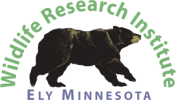Temperature in the den - UPDATE January 27, 2010
January 27, 2010 - 4:52 PM CST
The temperature outside this morning was -9F. Temperatures inside dens are the same as outside unless snow closes the entrances, in which case den temperatures rise to that of the soil. Lily’s big entrance will remain open.
There is only one warm place in the den—the space between Lily’s sparsely furred underside and the bedding. With her head tucked under her chest, her breath warms that small space while her legs form walls to contain the heat. Re-breathing the air reduces loss of heat and moisture.
Lily gets water from fat metabolism and hydrates the cub with her milk. Some mothers also eat snow. In Native American legend, Manitou sends snow in January, the Bear Moon, for mothers to wash newborn cubs.
It’s time to name Lily’s cub. We saw the great suggestions you had for the t-shirt and need more of that creativity for a name.
We’re looking for a name that reflects what Lily and the cub are doing for bears. They’ve stolen hearts and become ambassadors for bears. Watching Lily gather bedding before the birth and then go directly from the pain of labor to mothering the cub has been an epiphany for many. She has literally changed lives. In a world of strife and disaster, the den represents a peaceful place where a wild mother can devote herself to her cub.
Lily has a gentle, trusting spirit. Her trust of researchers made this unprecedented window into the wild possible. Lily is giving many people their first look at how real bears differ from the ferocious images of the media and taxidermy. Her gentle nature has drawn people in and made them want to learn more. This, in turn, makes people more willing to coexist with bears. Lily and her cub represent hope.
We’re looking for a unisex name that in some way reflects this. Please send your ideas to
—Lynn Rogers and Sue Mansfield, Biologists, North American Bear Center
